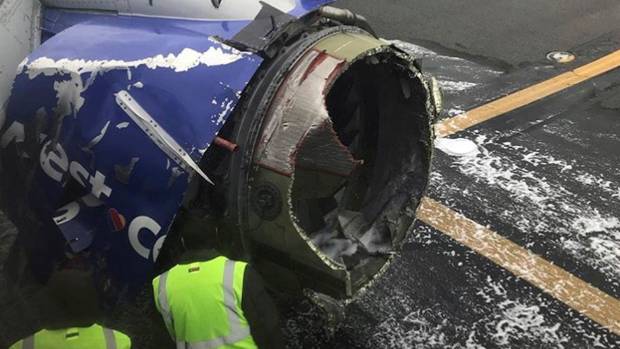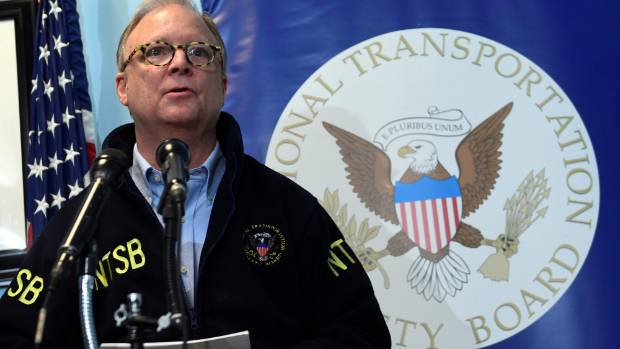Updated: 10:47pm – A mother-of-two has been identified as the victim from a US jet engine blow-out at over 9700 metres.
Shrapnel from the engine on the Southwest Airlines airplane smashed a window, setting off a desperate scramble by passengers to save a woman from getting sucked out.
Seven other passengers were injured. The dead woman has been named as Jennifer Riordan, a bank manager and mother-of-two from New Mexico.
News of her death was first shared by the assistant principal of the Albuquerque Catholic school attended by her two children.
In an email to parents, assistant principal Amy McCarty wrote that “the family needs all the prayers we can offer”.

Travellers said fellow passengers dragged Riordan back in as the sudden decompression of the cabin pulled her part way through the opening.
The pilot of the Southwest Airlines plane, a twin-engine Boeing 737 bound from New York to Dallas with 149 people aboard, took it into a rapid descent and made an emergency landing in Philadelphia as passengers using oxygen masks that dropped from the ceiling said their prayers and braced for impact.
“I just remember holding my husband’s hand, and we just prayed and prayed and prayed,” said passenger Amanda Bourman, of New York. “And the thoughts that were going through my head of course were about my daughters, just wanting to see them again and give them a big hug so they wouldn’t grow up without parents.”
Bourman said she was seated near the back and was asleep when she heard a loud noise and oxygen masks dropped. She said the plane was fairly quiet because everyone was wearing a mask.
Another passenger, Alfred Tumlinson, of Corpus Christi, Texas, said a man in a cowboy hat rushed forward a few rows “to grab that lady to pull her back in. She was out of the plane. He couldn’t do it by himself so another gentleman came over and helped to get her back in the plane and they got her.”

Fellow passenger, Eric Zilbert, an administrator with the California Education Department, said: “From her waist above, she was outside of the plane.”
Passengers commended one of the pilots for her cool-headed handling of the emergency. She walked through the aisle and talked with passengers to make sure they were OK after the plane touched down.
“She has nerves of steel. That lady, I applaud her,” Tumlinson said. “I’m going to send her a Christmas card, I’m going to tell you that, with a gift certificate for getting me on the ground. She was awesome.”
The National Transportation Safety Board says a preliminary examination of the blown jet engine shows evidence of “metal fatigue”.
In a late night news conference, NTSB Chairman Robert Sumwalt said one of the engine’s fan blades was separated and missing. Sumwalt said the blade was separated at the point where it would come into the hub and there was evidence of metal fatigue.
Sumwalt said part of the engine covering was found in Bernville, Pennsylvania, about 112 kilometres west of Philadelphia.
In a recording of conversations between the cockpit and air traffic controllers, an unidentified crew member reported: “We have a part of the aircraft missing, so we’re going to need to slow down a bit.” She also said that there was a hole in the plane and that she was told “someone went out”.
Passenger Marty Martinez went on Facebook Live while wearing an oxygen mask. He posted, “Something is wrong with our plane! It appears we are going down! Emergency landing!! Southwest flight from NYC to Dallas!!” After the plane landed, he posted photos of a broken window near the left engine.
Everyone started yelling to brace for impact as the plane came in for a landing, Bourman said. She said passengers clapped and praised the pilot after the aircraft touched down.

“We were very lucky to have such a skilled pilot and crew to see us through it,” Zilbert said. “The plane was steady as a rock after it happened. I didn’t have any fearing that it was out of control.”
Tracking data from FlightAware.com showed Flight 1380 was heading west over Pennsylvania at about 32,200 feet (10 km) and travelling 500 mph (800 kph) when it abruptly turned toward Philadelphia.
The last time a passenger died in an accident on a US airliner was 2009, when 49 people on board and one on the ground were killed when a Continental Express plane crashed on a house near Buffalo, New York.
Southwest has about 700 planes, all of them 737s, including more than 500 737-700s like the one in Tuesday’s accident. It is the world’s largest operator of the 737. The 737 is the best-selling jetliner in the world and has a good safety record.
Southwest CEO Gary Kelly said at a news conference in Dallas that there were no problems with the plane or its engine when it was inspected on Sunday.
The jet’s CFM56-7B engines were made by CFM International, jointly owned by General Electric and Safran Aircraft Engines of France.
CFM said it sent experts to help NTSB investigators. In a statement, it said the CFM56-7B has had “an outstanding safety and reliability record” since its debut in 1997, powering more than 6,700 aircraft worldwide.
Last year, the engine maker and the Federal Aviation Administration instructed airlines to make ultrasonic inspections of the fan blades of engines like those on the Southwest jet. The FAA said the move was prompted by a report of a fan blade failing and hurling debris. But it was unclear whether the particular engine that failed on Tuesday was covered by the directives.
“There’s a ring around the engine that’s meant to contain the engine pieces when this happens,” said John Goglia, a former NTSB member. “In this case it didn’t. That’s going to be a big focal point for the NTSB – why didn’t (the ring) do its job?”
Goglia said the Boeing 737 is a safe plane but engine failures happen from time to time.
“We’re pushing the engines to produce as much power as possible,” he said. “We’re right on the edge. Sometimes they fail, and that’s why the containment ring is there.”
In August 2016, a Southwest Boeing 737-700 jet blew an engine as it flew from New Orleans to Orlando, Florida, and shrapnel tore a 5-by-16-inch hole just above the wing. The plane landed safely. The NTSB said a fan blade had broken off, apparently because of metal fatigue.
Before Tuesday, Southwest had never had an accident-related fatality of a passenger, although a boy died in 2006 when a Southwest jet skidded off a runway at Chicago’s Midway Airport, crashed through a fence and collided with the boy’s family’s car.
– AP/Stuff
Featured image: The victim has been named as Jennifer Riordan.





























